Among much of the general public, the communications media, and even some architects and developers, there is a misconception that the production of structural steel results in more carbon emissions than the production of other inorganic structural materials. The global emissions footprint of structural steel is indeed troublesome; even the most sustainable steelmaking technologies use considerable energy; and production methods in some areas remain both dirty and energy-intensive—yet confusion between domestic metrics and global metrics, which include emissions from both traditional integrated blast furnace/basic oxygen furnace (BF/BOF) steel production and the far more sustainable electric arc furnace (EAF) method using recycled ferrous scrap, frequently obstructs an accurate assessment of the energy and emissions performance of the U.S. steel industry. The U.S. is a leader among nations where EAFs are now dominant, recycled content is the norm, and the steel industry exemplifies the operations of a circular economy.
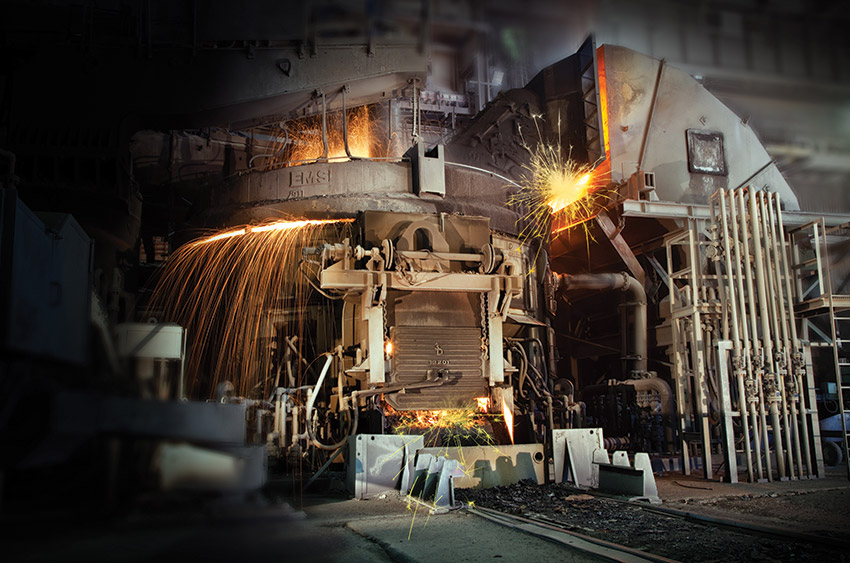
Photo courtesy of Nucor
An electric arc furnace (EAF), shown here in operation, uses up to 100 percent scrap steel and has approximately one third the CO2 emissions of a traditional blast furnace/basic oxygen furnace (BF/BOF).
“Steel has been recycled for over 4,000 years,” notes metallurgist and architectural/structural metals consultant Catherine Houska, recalling remarks she recently made to an American National Standards Institute technical advisory group. “If you go back to when mankind first started to use iron, it has been recycled very carefully since that time.” The long-established tradition of reusing scrap metal and melting it at temperatures that effectively remove impurities (since steel has a higher melting point than aluminum or copper and can be recycled indefinitely through the lifetimes of many buildings or products) forms a foundation for newer sustainable practices. These increasingly involve shifts to alternative energy sources, part of the broader decarbonization of infrastructure and the economy; designs that use steel in highly efficient ways, thanks in part to high-strength grades of steel that can carry more load with less bulk (see Architectural Record, February 2022, “Not Quite Your Grandfather’s Steel: High-Strength A913 in Today’s Green Construction”); computationally assisted analysis of structural loading, allowing increasingly precise allocation of materials; and, in certain prototype projects, advanced additive manufacturing technologies. The strength/weight ratios found in contemporary steel continue to enable lightweight structures with impressive aesthetics and structural performance (see Figure 1). Design and construction methods grounded in the capabilities of today’s steel industry can legitimately earn descriptions as green and clean.
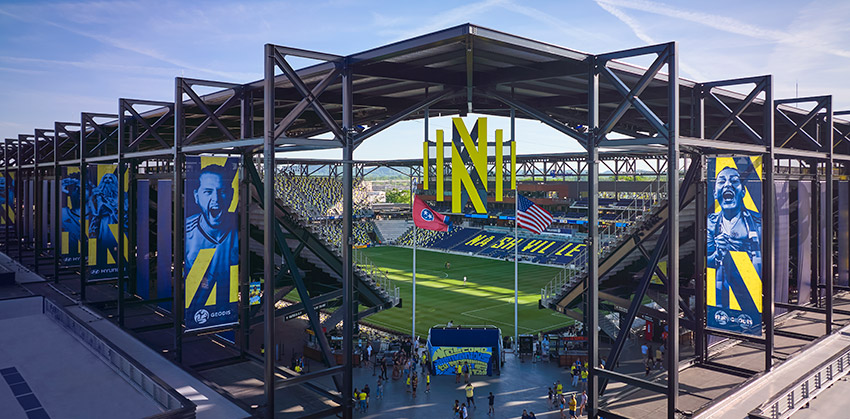
Photo courtesy of Tom Harris
Figure 1. GEODIS Park by Populous and Hastings Architecture, the new home of Nashville SC of Major League Soccer, features exposed slender beams of structural steel produced in an EAF. It is the largest dedicated soccer stadium in the U.S. or Canada and a winner of a 2024 AISC Innovative Design in Engineering and Architecture with Structural Steel (IDEAS²) Award. Source: AISC
“The biggest misconception I encounter,” says Max Puchtel, SE, PE, director of government relations and sustainability at the American Institute of Steel Construction (AISC), “and this is common when you look at any kind of third-party webinar or publication about the steel industry on sustainability, is people will tout global numbers for emissions responsibility for the steel industry when they’re talking about the domestic steel construction industry. So you’ll see things like, ‘The steel industry is responsible for 8 percent of worldwide emissions,’ which is true, but that’s a global number. It reflects the fact that worldwide, there’s about a 70/30 split of integrated traditional steelmaking relative to modern recycled-content steelmaking.”
“In the U.S., about 75 percent of all steel is made with an electric arc furnace,” notes Philip K. Bell, president of the Steel Manufacturers Association, the Washington, D.C.-based organization representing the domestic EAF industry. “Most construction materials—whether they’re structural beams, long products like rebar, wire rod for reinforced concrete, and even plate—are made by EAFs,” he continues. “About 99 percent of all long products are made by EAF. About 80 percent of all structural products are made via EAF, and about 75 percent of most plate products are made via EAF.... This trend is growing not only in North America, but around the world. Increasingly, we see foreign steel industries trying to make their steel industry look more like ours, where they are retiring old blast furnaces that use extractive methods of mining iron ore and coal and replacing them with EAFs. This is particularly true in Canada, Germany, and the U.K.”
A move toward EAF is not yet the case, however, in China—the nation that produces over half the world’s crude steel annually. China’s proportion of EAF facilities also lags well behind those of the U.S. and other world leaders, with estimates varying, but some credible sources suggesting a mere 10 percent EAFs in 2020, with 15 percent as an aspirational goal by 2025 (Zhang and Chow); large-scale new BF/BOF construction persists in that nation, despite stated intentions to encourage scrap-fed EAFs (Shen and Myllyvirta). The locked-in commitment to BF/BOF mills by the world’s largest steel producer is a major reason the global steel industry, assessed as a whole rather than nation by nation, can appear anything but green.
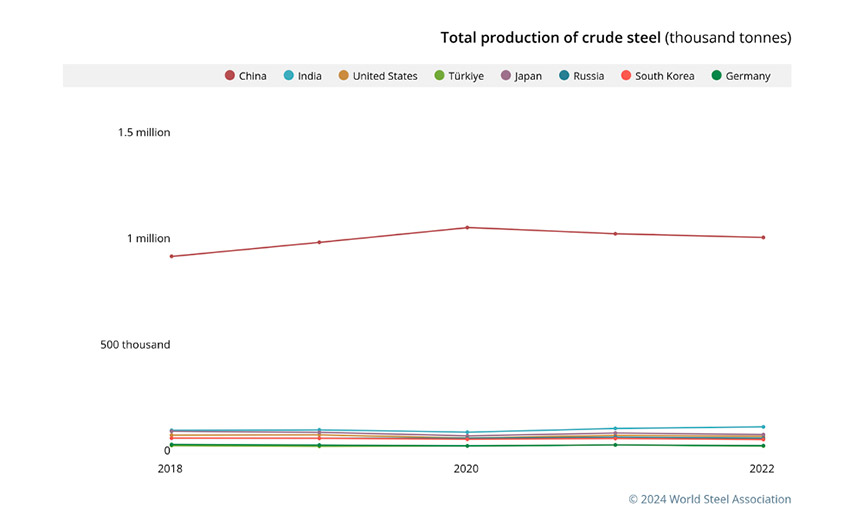
Graph courtesy of World Steel Association
Figure 2. Crude steel production in the top eight nations, 2018-2022. Source: World Steel Association, Steel Data Viewer.
With global climate change making the conversion of high-emissions extractive processes to circular, sustainable, and resilient processes an increasingly urgent priority, and with professionals, clients, and regulatory bodies all paying serious attention to energy and emissions metrics, improving the performance of this critical industry strikes observers inside and outside the field as a powerful imperative (Muslemani et al.). The relevant metrics include both embodied carbon and operational carbon, though current building codes chiefly address their attention to the latter. These measurements apply to all three scopes of emissions: scope 1 includes greenhouse gas (GHG) emissions from sources that an organization controls directly; scope 2 includes indirect GHG emissions associated with the purchase of electricity, steam, heat, or cooling; and scope 3 includes all other indirect GHG emissions resulting from activities in an organization’s value chain (Greenhouse Gas Protocol).
Roughly 42 percent of GHG emissions—an annual total of 36.3 gigatons in direct and indirect energy and process-related CO2 emissions—can be attributed to the built environment, according to architect Edward Mazria’s research and advocacy organization Architecture 2030. Embodied carbon (emissions directly associated with the manufacturing of building materials and building construction) accounts for approximately 11 percent of annual global GHG generation, according to one recent assessment (Carbon Leadership Forum 2020), and for the majority of the carbon emissions associated with global new building and infrastructure between now and 2030 (Architecture 2030). BF/BOF mills can use up to 30 percent recycled scrap in place of extracted iron; with EAFs, the recycled proportion is 100 percent. Steel made in the U.S. currently includes 93 percent recycled content according to the most common estimates, and when used in designs allowing disassembly and separation, it is 100 percent recyclable for future applications.
Replacing BF/BOF methods with EAF worldwide, as North American manufacturers have been doing since the 1980s, is a potent instrument for improving the steel industry’s environmental profile. The global average CO2intensity of BOF production in 2022 was 2.33 tons of CO2 per ton of steel, but only 0.68 tons of CO2 per ton of steel for EAF production (World Steel Association 2023). The industry-wide combined figure, 1.91 tons of CO2per ton of steel, is thus nearly a threefold overestimate of the EAF steel industry’s emission intensity. National steel industries’ environmental profiles vary widely because of rates of EAF adoption, electrical grid conditions, energy sources, the age of facilities, and other factors (Hasanbeigi). Globally, an estimated three-quarters of steel production uses the BF/BOF process, and one-quarter EAF; in the U.S., those figures are essentially reversed.
AISC president Charles J. Carter, SE, PE, PhD, boils the relative footprints down succinctly: “If you buy a ton of steel from China or a ton of steel from the U.S., there’s one-third the carbon in the ton that you’ve bought from the U.S. versus what you get from China. It’s the single thing that a designer could do in the U.S. that would make the biggest impact on sustainability: to require domestic product on a domestic job in the U.S.” Governmental programs supporting domestic green industry such as the Federal Highway Administration’s Buy America program (23 U.S.C 313), the Federal Buy Clean Initiative (part of Pres. Biden’s 2021 Executive Order 14057 on Federal Sustainability), the Buy Clean California Act, and similar initiatives in other states and municipalities thus advance the industry’s emissions-reduction goals. The AISC supports Buy Clean efforts that treat all construction materials equally, offering detailed recommendations for policy makers crafting future Buy Clean regulations (AISC 2022).
“We don't view the steel industry as hard to abate,” says Tim Hill, general manager of sustainability solutions at Nucor, the Charlotte, N.C.-based firm that has become both the largest steel producer and the largest metal recycler in North America. “It’s actually fairly simple. We have the technology; there's one technology right now that can reduce carbon emissions at scale in steel production. It’s just going to be incredibly expensive, because 70 percent of the globe’s steel production relies on a method that is really dirty, and it’s old, and it’s asset-intensive, and a lot of those assets are decades and decades old.”
Because it began operations in the 1960s and embraced EAF technology early on due to its cost-effectiveness, Nucor was able to leapfrog traditional manufacturers’ methods around the time environmental concerns began attaining public prominence. The challenge for other producers and for related professions is to overcome the sunk-costs fallacy that keeps some nations and institutions wedded to BF/BOF, and to transform operations accordingly. Firms including ArcelorMittal, U.S. Steel, Korea’s POSCO and Hyundai, and others, have successfully adopted EAF production along with other clean technologies, regardless of media coverage (e.g., Reed) that overlooks existing green practices, describes steel as a “leading polluter,” and assumes that coke is still universally burned in structural steel production (Swedish firms Svenskt Stål AB [SSAB] and H2 Green Steel have gained publicity as “green steel” makers, joining Indiana-based Steel Dynamics, Boston Metal, Brazil's Gerdau, Nucor, and others in abandoning coke).
The obstacles to that transformation are distinct from questions of differential national development. Not every nation, company, or region can enjoy the leapfrogging timing that benefited Nucor. Although more recently developing economies sometimes outperform older nations or regions in certain sectors (e.g., mobile phones bypassing land-line service in areas where copper-wire infrastructure never appeared, or solar energy bypassing fossil-fuel extraction and dependence), this pattern is less clear in the global steel industry. China, Hill points out, is doubling down on BF/BOF facilities. “As steelmakers across the world are looking for ways to decarbonize their operations, new blast furnace capacity is being added in China, India, and much of Asia. They are not converting current blast furnaces to cleaner EAF technology, but they’re actually building more capacity for old, dirty, inefficient steelmaking.”
Short-term economic decisions that exclude the environmental externalities of emissions and climate disruption make steel appear, from a distant perspective, to be a major part of the problem. Yet in places where EAF production is commonplace, combined with increased adoption of renewable energy sources and design innovations that promote more efficient use of materials, steel is very much part of the solution. Specifying structural steel supplied by an EAF-based source is a choice any environmentally conscientious architect can make in confidence.
GREENING THE ENERGY SOURCES: BEYOND THE BAU-HAUS
Aspects of the domestic steel industry's progress toward sustainability, Bell says, include nationwide use of natural gas rather than coal, increasing shares of renewable energy, and use of direct reduced iron (DRI) along with scrap. Among multiple programs for improving the industry’s carbon footprint, he says, one of the most reliable sources of information is the U.S. Department of Energy's Industrial Decarbonization Roadmap, a comprehensive sector-by-sector analysis of ways for manufacturers to reduce emissions (Department of Energy 2022). Using four scenarios reflecting increasingly aggressive technology and policy improvements—business as usual (BAU), moderate, advanced, and near-zero GHG—the Roadmap identifies increasing the share of EAF steel as the primary way for the nation's steel industry to lower its energy intensity.
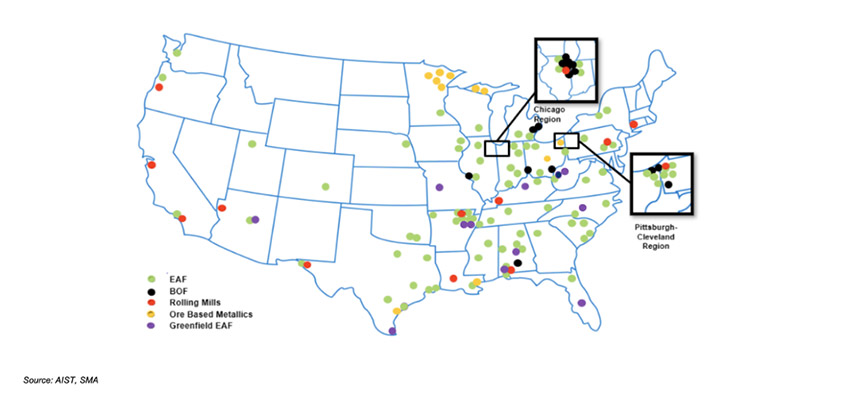
Image courtesy of Steel Manufacturers Association
Figure 3. Geographic footprint of steel facilities in the United States. Source: AIST, SMA
The Roadmap’s prediction that “by 2050, that 90 percent of all steel made in the United States will be made by some other route than integrated steel production or blast furnace steel production,” Bell says, underscores the central role of EAFs in continually upgrading steel’s emissions performance. “If you look at the investments that have taken place between 2021 and are going to go through the year 2025, there’s been over $18 billion in CapEx [capital expenditure] committed or invested in EAF steel production,” he adds, finding concurrence on the importance of EAF steel among “the federal government, the OECD (Organisation for Economic Co-operation and Development), the World Steel Association, and the people with the money.” Most of this investment is by SMA members along with “integrated producers like U.S. Steel, who’s been in the news a lot lately... closing down their blast furnaces and investing in EAF production by acquiring Big River Steel and building a new EAF mill in Arkansas.” (See Figure 3 on the geographic distribution of steel facilities in the U.S.)
U.S. Steel and Nucor are among numerous steelmakers expanding facilities around the nation in response to rising demand and public-sector incentives, along with Steel Dynamics, the currently Russian-owned Evraz (likely to be under new ownership soon, as its part-owner Roman Abramovich is under international sanctions), and Irving, Texas-based Commercial Metals Company (Giusti and Leggate). The recent proposal for Nippon Steel to acquire U.S. Steel may accelerate Nippon Steel’s transition from BF/BOF to EAF facilities; though speculation may be premature because of the contingent status of the sale, Nippon Steel’s position among World Steel’s 2022 Steel Sustainability Champions (World Steel Association 2022) and its declaration of a move toward EAFs and a goal of carbon neutrality by 2050 (Nippon Steel 2023) imply that the firms’ priorities are similarly aligned.
Much of the uncertainty in assessing a product or building’s environmental impact results from scope 3 emissions, which depend on the available power sources, a factor that is only partially under a producer’s control. Houska points out that aluminum plants, which require substantially more energy than steel mills, have often been sited near hydroelectric sources or other sources of cheap local energy. The more alternative energy becomes economically favorable and local electrical systems move from fossil-fuel-based BAU to renewables, the more EAFs will continue to reduce their emissions. More advanced use of alternative energy in European nations, she notes, contributes to low carbon footprints there. In contrast, unreliability of the electrical grid in India, Bell adds, is one of the reasons that nation’s fast-growing steel industry (currently second in the world after China, though not among the top ten a decade ago) has been slow to adopt EAF technology.
In 2018 (the latest date used by the Roadmap for its analyses), natural gas accounted for 37 percent of the U.S. steel industry’s energy use, the highest share among energy types (U.S. Energy Information Administration 2021). Natural gas produces substantially lower emissions per unit of energy than coal and coke, the primary energy sources in China, India, and other BF/BOF-dependent steel producers. Gas is classified as a fossil fuel, carrying risks associated with leaks and drilling, but has a cleaner emissions profile than coal or petroleum. About 117 pounds of CO2 are produced per million British thermal units (MMBtu) equivalent of natural gas, according to the U.S. Energy Information Administration (2022), compared with more than 200 pounds of CO2 per MMBtu of coal and more than 160 pounds per MMBtu of distillate fuel oil. Natural gas is widely (though not universally) defined as a bridge fuel in the national shift toward renewables.
Puchtel summarizes the national energy-source narrative encouragingly: “Over the past 30 years, the U.S. has seen a switch in our power generation, reducing coal-based and increasing natural gas-based. Natural gas, of course, is still a fossil fuel, but it has about half of the carbon footprint that coal-based generation does. So by virtue of the coal numbers and the natural gas numbers flipping over the past 30 years, that's one of the primary reasons why the U.S. electrical grid is relatively much cleaner, both relative to ourselves and compared to the world.”
Hydrogen, Puchtel observes, is increasingly cited as a carbon-free energy source in Europe and the U.S., with some mills outfitted to replace natural gas with hydrogen to fuel reheat furnaces for final shaping and processing of steel. “It seems to be feasible in experiments,” he notes, “but we're still waiting to see it used at scale. The problem with green hydrogen is that once you have it, it’s great, but in order to create it, it takes an enormous amount of energy to do it. And in order for it to be green hydrogen, that enormous amount of energy all needs to be renewable energy.” Hill has observed multiple new technologies using green hydrogen but views them as “in the nascent stage and not economical.... The challenge is, even after you apply the subsidy under IRA (the Inflation Reduction Act), hydrogen is still more expensive than the cost of natural gas.” Bell, likewise, describes hydrogen-based steelmaking methods, reducing iron to DRI for use in the production process, as not yet scalable in the U.S., though European manufacturers aided by government subsidies and investments have made attention-getting headway with it. With Sweden’s Hybrit (Hydrogen Breakthrough Ironmaking Technology), he says, a “fossil-free” DRI steel developed by SSAB, the mining company Luossavaara Kiirunavaara Aktie Bolag, and the energy supplier Vattenfall, “it’s not done on a large scale, and the focus is actually to make flat-rolled steel for the automotive industry, not for the construction sector.”
“The U.S. government is doing all it can to incentivize hydrogen-based steelmaking and to get people more interested in it,” Bell observes. “The Department of Energy recently identified several areas that will start research on what are called hydrogen hubs. One of the reasons hydrogen-based steelmaking has not taken hold in the U.S. is hydrogen is a very volatile substance; you have to be very careful when you store it, when you distribute it, when you ship it. And until you have a network of these hydrogen hubs existing where you can safely store it; until you have the pipelines needed to safely transport it; and until you have the trucks and other vehicles to get it from point A to point B, it’s going to be a very incremental approach. This is not something that’s going to happen in the next two or three years; it might be a decade before there’s any meaningful inroads made into hydrogen-based steelmaking here in the U.S.” The Regional Clean Hydrogen Hubs are components of Energy Secretary Jennifer Granholm’s mission to incentivize the long-range transition from fossil-fuel dependent BAU to a hydrogen-based economy, Bell adds; while recognizing the importance of that effort, he sees EAFs as a proven and readily available form of green infrastructure.
Steelmakers’ movement toward renewable energy is not as swift or thorough as many would prefer, for the all-too-familiar reasons of scale, storage, and consistency. Hill notes that in the case of Nucor, “we’re 40 percent renewable today, because the grids that we’re on are there, given where they are today in the different parts of the country.” When the firm’s new sheet steel mill opens in another roughly two years, requiring hundreds of megawatts of power at peak, he says, “when we throw the switch for that melt shop, you’ve got to have instant power. It’s got to be firm baseload energy. Solar and wind do not provide that for us in the future.” The firm is exploring nuclear fission and fusion as additional carbon-free sources, Hill says, including “small modular reactor technology on the fission side, similar to what the U.S. Navy has used for decades in the nuclear subs.” In September 2023, Nucor and Washington-based fusion-power firm Helion Energy announced an agreement to develop a 500-megawatt fusion plant directly powering a Nucor steelmaking facility, with an operation target of 2030. “If we want clean 24/7 carbon-free energy, you have to look at nuclear, because that’s the only thing from a firm baseload standpoint,” Hill says. Agreements with a wind farm in Texas and a solar project in Kentucky also demonstrate that Nucor continues to expand support for those renewable forms while looking to nuclear as a reliable source for the scale of energy its facilities need at present.
Along with energy-supply variables, the availability of scrap is an essential factor determining an EAF’s operations and emissions effects. Dennis Pilarczyk, manager of building solutions at Nucor, says, “Right now, there’s a concern that if everybody flipped from BOF to EAF tomorrow, there wouldn’t be a scrap supply to support it.” At least in the U.S., he believes, a shortage scenario is improbable and should not be a pretext for complacency about BAU. Given the extent of both construction and production of automobiles and other metallic goods within recent decades, with more buildings and products now coming offline, the U.S. is a net exporter of scrap, Pilarczyk says. A recent report prepared for the SMA, analyzing changing product lifespans and their effects on the scrap supply as well as a coming global surge in scrap as China’s steel sector has grown, supports the proposition that ample scrap is available, and will remain so, to support the continued expansion of EAF facilities (Brady and Eggert).
Other commentators, particularly focusing on supply chains outside the U.S., are less willing to dismiss concerns over the scrap supply. “We are still building a lot of infrastructure, and we are building at a quicker rate than we are generating scrap material,” says Leroy Gardner, PhD, FREng, professor of structural engineering at Imperial College, London. “As things stand, I think there's probably a global overdemand for scrap steel, and that is a limitation; we will still need for some period to be producing new steel from raw materials [by the] blast-furnace route. And you could imagine at some point there will be something like an equilibrium of scrap and demand, but we're certainly not going to be there for a number of decades.”
Houska views this condition as an impetus for architects, fabricators, and product designers to consider an underappreciated aspect of cradle-to-cradle circularity: “the design of products so that they can be separated.” More attention to end-of-life disassembly would improve the flow of materials into the scrap supply, she says, and reduce the problem of removing impurities at the melting stage. “If you are going to combine metals, for example, wall panels often might have stainless steel on the outside and aluminum on the inside of the sandwich panel, and if you can’t effectively separate the metals, then that might not be recyclable. So keeping it all steel would make a huge difference.”
DEFUSING THE GREENWASHING CRITIQUE THROUGH STANDARDS
Efforts to decarbonize the economy must come to terms with the fact that steel inevitably contains carbon. “You’ll never decarbonize it,” says Bell, “but you can lower the carbon emissions of the steel you produce” with EAFs, scrap recycling, and cleaner energy sources; decarbonization in construction or any other field is a matter of degree and measurement. These efforts’ vulnerability to accusations of greenwashing, a nearly inevitable reaction as terms like “green steel,” “clean steel,” and “sustainable steel” circulate, are reducible when standards are developed by recognized authorities and applied uniformly throughout the field.
Sustainability standards vary, Bell acknowledges: “there’s over 50 of them out there. But probably the top one that defines it in a way that's clear and easy to understand is the Global Steel Climate Council (GSCC) standard,” which the SMA supports. It is “based on a very simple concept. Steel is going to be green or not based on the absolute value of its CO2 emissions; you don’t need anything else involved in that calculation. Social responsibility is great. Planting trees is great. All of that is great. But at the end of the day, what this is about is carbon emissions, and we have a standard that’s based on a single line of attainment. If you’re above that line, you're high-emitting. If you're on that line, you’re okay; if you’re below that line, you’re even better, but you still are incentivized to continually improve and lower your emissions so that it’s aligned with the 1.5-degree scenario outlined by the Paris Climate Agreement.”
The international nonprofit GSCC formed in 2022 and issued its standard in 2023, rejecting calls for a “ferrous scrap sliding scale” that would allow extractive steelmakers a “green” label based on emissions up to ninefold higher than that applied to recycled products (Global Steel Climate Council). The GSCC’s standard addresses Scopes 1-3 GHG emissions from scrap collecting, processing, and hot rolling; regularly tightens its requirements along a “decarbonization glidepath” toward net zero emissions by 2050 (see Figure 4); requires independent third-party verification of calculations and reduction targets; offers product certification as an option, lasting three years and renewable after that period with verification held to the current standard; and excludes carbon offsets or insets (compensatory activities outside or inside a company’s value chain, e.g., purchasing external carbon offsets or planting trees as an onsite carbon sink, respectively), a common greenwashing mechanism. “The greenwashing is really being done by those that are trying to promote the old, dirty way of making steel,” Bell contends, “trying to say that steel made with a blast furnace can have the potential to be just as clean as steel made in an EAF.”
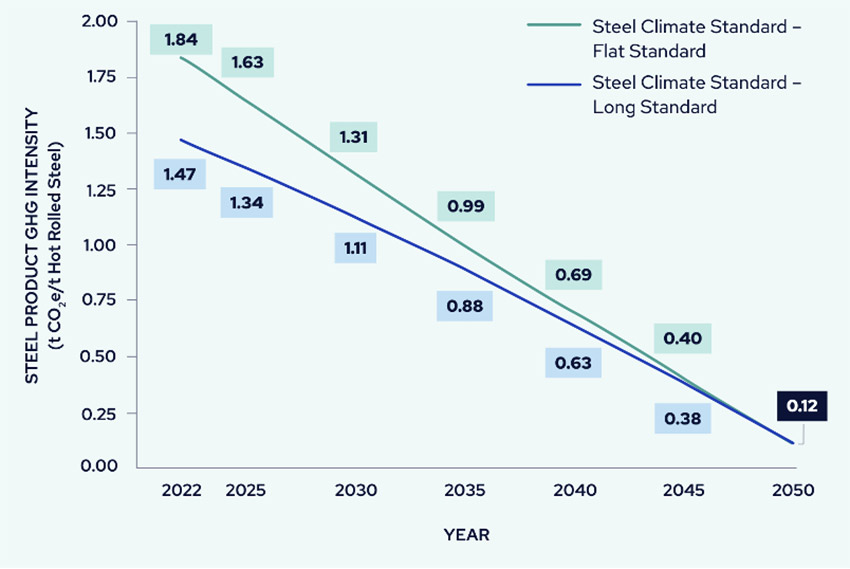
Graph courtesy of Global Steel Climate Council
Figure 4. Steel Climate Standard flat and long steel product intensities. Source: Global Steel Climate Council, The Steel Climate Standard, Fig. 3-1.
Houska agrees that the industry needs rigorous and accepted benchmarks, “similar to the standards that were established by the wood industry to certify sustainable forests and forest management as opposed to clear cutting.” Her experience with standards development includes chairing the subcommittee on E60.80 General Sustainability standards for ASTM (previously the American Society for Testing and Materials) and service on several AISC committees. Standards developed by professional organizations for carbon steel, stainless steel, alloy steels, and other metals, she notes (citing the Copper Mark, the Nickel Institute, the International Molybdenum Association, the Chromium Development Association, and the International Zinc Association) are gradually overcoming gaps in data on life-cycle assessment of products using the materials and submitting standards to the ASTM and International Organization for Standardization, which carry more authority than intra-industry organizations do. “There is a huge effort on the part of the International Council on Mining and Metals to develop standards. There has already been an effort on the part of specific alloy elements to create standards and certification systems that are third-party-verified, [ensuring] that mines are very responsible.... There are mining operations, I'm fairly certain, where their extraction facilities could get LEED Platinum. They're using solar power; all the water that is used is carefully processed.” Even in parts of the world where provisions are less stringent, she says, “there are mines that are really taking significant actions to make sure that what they're doing is sustainable and protecting the miners' lives. Mining isn't what it was 100 years ago.”
Puchtel points out that governmental decarbonization standards, initiated in 2008 by California's CalGREEN (Green Building Standards Code, Part 11 of the state's building code) and followed by similar programs in other states, are likely to appear soon at the federal level as an Environmental Protection Agency initiative. “Part of what the EPA is doing right now,” he says, “with money they received from the Inflation Reduction Act, is creating a labeling program similar to what consumers are familiar with, like WaterSense or EnergyStar. So EPA plans to create a label program that will rate construction materials based on their embodied carbon.” Steel is one of four materials (along with cement/concrete, glass, and asphalt) identified in an EPA Interim Determination as priorities for Environmental Product Determination assistance and the new labeling program (EPA 2023). Specifiers and clients alike, provided the program is not derailed by politics, will benefit from clearer communications about the embodied-carbon effects of the available materials. Puchtel's colleague Carter also points out that code centralization in the form of the International Building Code and its incorporation of AISC standards by reference, along with the economic advantages of sustainable choices (already evident from the U.S. shift to EAFs) “makes it somewhat idiot-proof, regardless of how politics goes.”
Rarely, but sometimes significantly, a technology will be too new for existing standards to offer meaningful guidance (see Case Study below: “MX3D's Amsterdam Bridge: Pioneer Project or One-Off?”).
CASE STUDY: MX3D'S AMSTERDAM BRIDGE: PIONEER PROJECT OR ONE-OFF?
One innovation in the use of steel lacks impressive emissions metrics─for now─but points the way toward a promising disruption in design and material delivery. A new method of producing steel directly at the site needed, printing three-dimensional forms from wire feedstock in layers with a digitally guided robotic instrument, offers both the possibility of extraordinary efficiencies and the challenge of scaling up the process to the point where those efficiencies might benefit a wide range of structures.
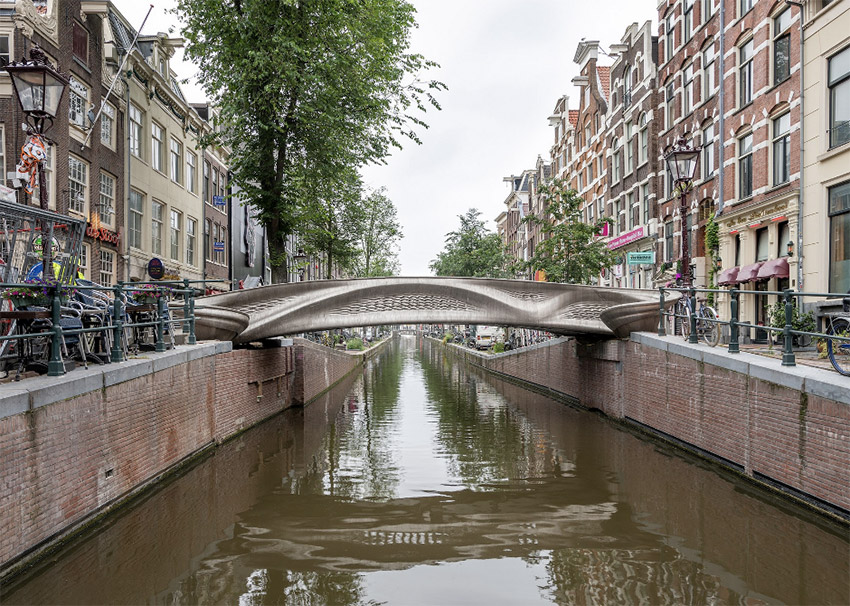
Photo © Thea van den Heuvel; courtesy of Arup
Figure 5. MX3D's bridge in place across the Oudezijds Achterburgwal, Amsterdam.
The Dutch additive-manufacturing startup firm MX3D, a spinoff from the design agency Joris Laarman Lab, surprised observers (and themselves) by creating the world's first functional 3D-printed stainless steel pedestrian bridge, which from 2021 to 2023 was placed across the Oudezijds Achterburgwal canal in Amsterdam's medieval-era red-light district, De Wallen. The proof-of-concept project was the culmination of a lengthy process of experimentation, testing, and approval; those involved were astonished to find how readily the bridge passed loadbearing tests, then withstood heavy foot traffic while open to the public. With important caveats, particularly about energy consumption and emissions, this method could transform certain segments of the steel design and construction fields. Also known as wire-arc additive manufacturing (WAAM), a technology first reported in 1925 when Ralph Baker patented a method of using an electric arc as the heat-energy source for making metallic ornaments, it offers observers the semi-magical sight of robotic arms essentially drawing fully formed structures in open space.
Gijs van der Velden, founder and CEO of MX3D, recalls the firm's early explorations with concrete, resins, and other printable materials after initially purchasing a robot in 2011. “Our goal was basically to see if we could realize these advantages of 3D printing,” he says: “saving materials, more geometric freedom, a new design language.” Chief technical officer Tim Geurtjens had the idea of attaching a welding machine, and after sharing experiments via YouTube from the outset, the firm attracted interest from Autodesk, Arup, ArcelorMittal, and academia. Additional projects with complex geometries in 3D-printed steel have included chairs, benches, bicycles, and maritime propellers.
“We came up with an idea that we could do together with this community, and that was the bridge,” van der Velden continues. “So we said, 'Let's just come up with the wildest idea that we think could be done with a technology like this.' It's maybe a little bit over the top, but it's going to hopefully inspire a lot of people to do the same.” The work, begun in 2015 and carried out over three years in collaboration with engineers from Imperial College in London, the University of Twente in Enschede, and Arup, proceeded from printing test plates to printing segments of the bridge to finite-element (FE) modeling and tests of the segments, and eventually to printing the full 10.5-meter-long structure (see Figures 5-8) for initial public unveiling during Dutch Design Week 2018.
Welding two parts together typically creates a weak point, van der Velden says, but printing layer upon layer amounted to “creating a full homogeneous material that doesn't have that same problem as a typical weld does.” With no building code applicable to the unprecedented material and design, the team developed a testing plan to determine whether test results would correspond to the behavior of the full structure; after destruct tests on pipes, connections, and other segments, they proceeded to print a 2.5-meter length of the bridge, then the complete bridge.
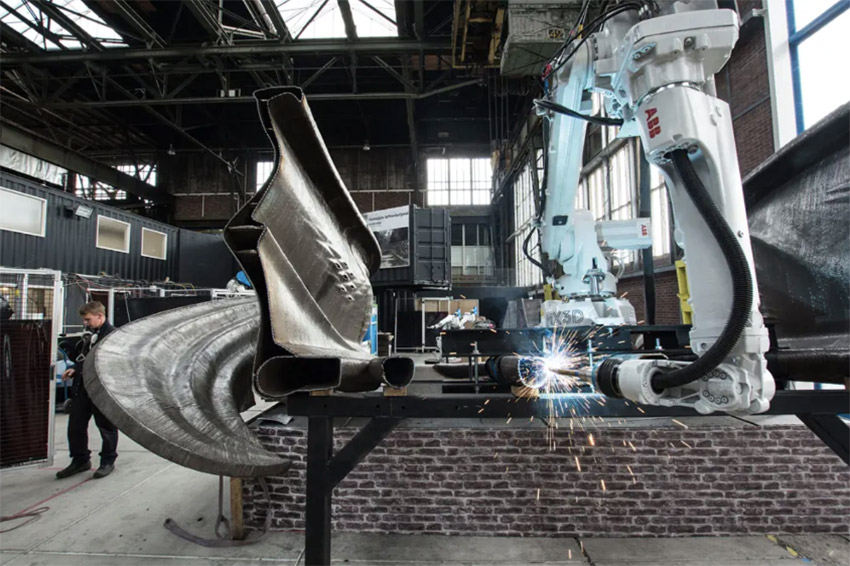
Photo © Olivier de Gruijter; courtesy of MX3D
Figure 6. Printing of MX3D's bridge in progress.
Initial plans to conduct the printing in situ were abandoned as a safety precaution and to minimize security costs; instead, when the permit was approved, it was printed offsite and craned to the canal for installation. Permitting, as one might expect with a radical design in a historic neighborhood, was a slow process, though interest on the part of Dutch Queen Máxima helped expedite the effort. Negotiations with urban preservationists led to a decision to install the bridge as a two-year art project rather than a permanent feature; it remained in place from its opening in July 2021 to October 2023 before removal to another site for further testing.
“We didn't have unlimited time and budget,” van der Velden recalls, “so we said, 'Yeah, we're just going to print the whole thing, and then we're going to test it at the end, well over the design load.” Without claiming to understand the new material thoroughly yet, MX3D built in enough extra mass and structural redundancies to withstand more stress than it would encounter with “human jumping at the maximum capacity.” Even with the material reduced by 20 to 30 percent, he estimates, structural integrity would not have been compromised.
“The first bridge, basically, was over-safe,” van der Velden summarizes; “it's really way too heavy, still, for a 3D-printed bridge, which typically should be lightweight. But we felt that the biggest achievement of the project would be just to show that it would be possible in the first place.” The final design by Laarman included a substructure, handrails, deck plate, end beams, and non-structural decorative curving forms that impart a futuristic and biomorphic aesthetic; all parts except the deck plate and end beams were created through WAAM with six-axis robots. The structure is also a “smart bridge” incorporating a system of structural and environmental sensors developed by Arup and Autodesk. These include load cells, strain gauges, displacement transducers, inclinometers, accelerometers, and thermistors (Wynne et al.), allowing detailed analysis of performance during public use and feeding data into a digital twin of the bridge maintained by the Alan Turing Institute's Data-Centric Engineering Programme in London.
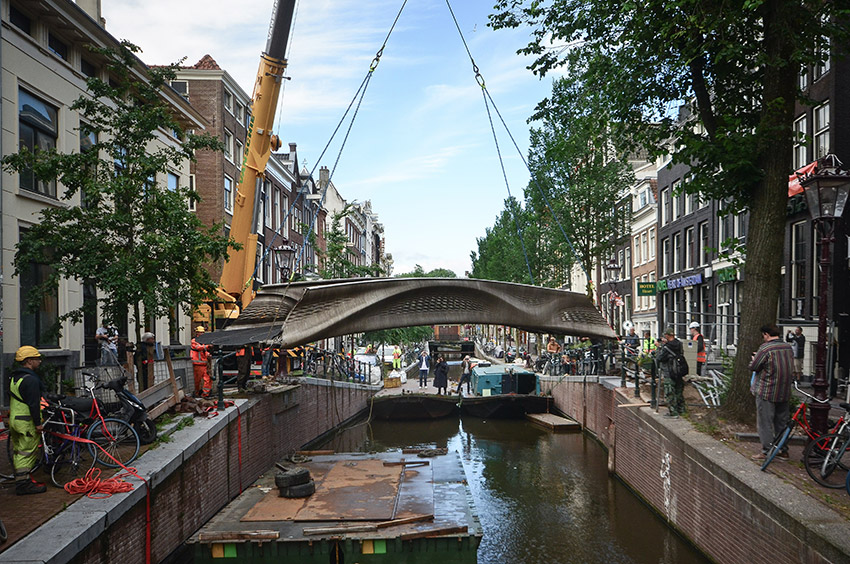
Photo © Adriaan de Groot; courtesy of MX3D
Figure 7. Placement of MX3D's bridge by crane, July 2021.
Leroy Gardner, PhD, FREng, professor of structural engineering at Imperial College in London, headed the academic consulting team on the project. After performing tensile coupon tests to determine mechanical properties, rigorous FE analysis in Abaqus to verify Arup's simpler early models (see Figure 9), tests of parts of the bridge to destruction, then loading tests of the full bridge conducted at the University of Twente in Enschede, withstanding up to 20 tons (beyond the design load), the Imperial group confirmed that it would be fit for purpose (Gardner et al.). Local authorities required the challenging loading tests, he recalls, to ensure public safety with a type of material and infrastructure for which no standards existed. Dynamics under footfall loading, like the harmonic movements that made London's slender Millennium Bridge notoriously unstable at first, were “not a particular issue” here, he reports, because the massing and form of MX3D's bridge were more robust.
The design was driven architecturally rather than by material-conservation considerations, Gardner says. “There's always a little bit of a tradeoff between the exotic shapes that you can produce versus making it as structurally efficient as possible. For me, the most important thing is about the potential of 3D printing to enable optimized shapes, and minimum-material-usage structures, to be realized.... With 3D printing, it is as easy to make optimised shapes as uniform shapes, unlike with traditional manufacturing, so you can put the material where you need it, using less material. And for me, 3D printing or additive manufacturing and optimization go hand in hand. Working together, I think that will be a way of reducing the carbon footprint of structures in the future.” Scaling approaches like MX3D’s up to a replicable status, rather than require extensive bespoke testing in each case, will depend on whether codes will shift to accommodate advances such as computationally assisted design. Gardner is active in code development in Europe and the U.S., though he acknowledges that “in terms of codes for additive manufacturing, and particularly for additively manufactured structures, it's still very early days.”
Mattia del Giacco, PhD, chief operating officer at the Swiss firm Montanstahl AG's Conroe, Texas, subsidiary Stainless Structurals (a downstream manufacturer that was not involved with the Amsterdam bridge but uses related laser-welding methods), comments that “when you use new technology like 3D printing or laser welding, you can go closer and closer to what the architect or the engineer or the designer needs, and this minimizes the waste. If in the past you had to design with standard shapes, so you have to buy a 20-footer even though you need 12- or 14-foot long bars, nowadays it's more and more common to be able to source the 14 feet or whatever length you need.” Limitations of current powder-fed 3D printing, he says, are a matter of productivity and speed: “We're talking about maybe one ton per day of deposition, which is very low in the steel industry.” Bespoke 3D printing extends the material saving over standard members to a precise degree, del Giacco finds, liberating architects from the options found in catalogs. “A key point for architects and designers,” he says, “is try to find a manufacturer who can really start from their ideas and make it become reality without wasting material or energy.”
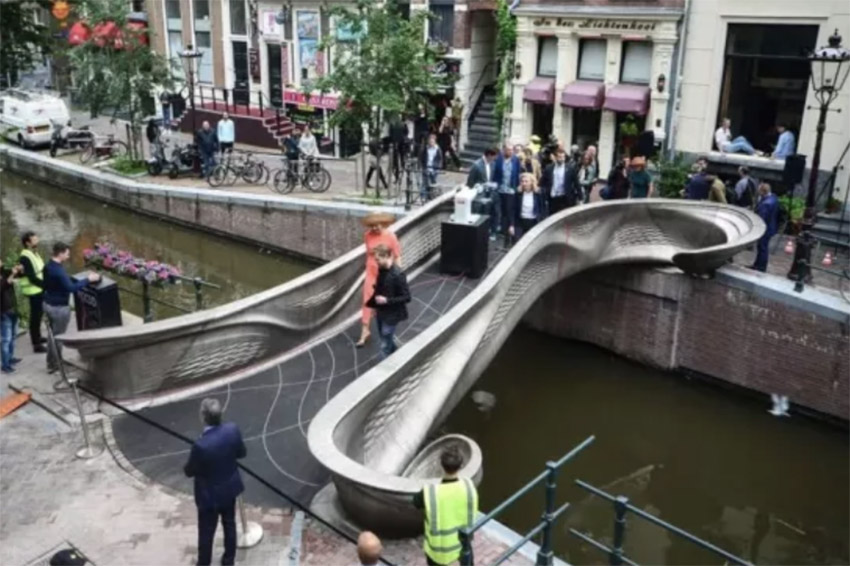
Photo © Adriaan de Groot; courtesy of MX3D
Figure 8. Queen Máxima of The Netherlands opens MX3D's metal 3D-printed bridge in Amsterdam, July 2021.
A particularly promising area for WAAM is “complex-geometry diagrid structures,” says Mathew Vola, an Arup Fellow and director specializing in computational design, who leads Arup's structural-engineering practice in the Netherlands and worked with MX3D on the bridge. “If you create the node with printing, you can have standard steel members, circular sections, or maybe even timber members, and then if you make the connection in steel and solve all the complexity within that joint, I see a future for this technique.” With 3D printing, “we can deposit our material where we want,” Vola explains; it becomes possible to “look at structural optimization algorithms to see where the material needs to be... That's something [that] with traditional steel beams you cannot do.” As a different set of Arup engineers did on a large scale with the irregular diagrid of OMA's CCTV tower in Beijing two decades ago, the bridge engineers were able to add and subtract material proportionate to local stresses, here with the nuanced curves of computationally aided design. The process contributed to the bridge's aesthetics: “We found that if you start putting some curvature in plan in the bridge,” Vola says, “even though it's typically a U profile, the stress patterns become pretty beautiful.”
Some aspects of the design, Vola recalls, evolved to meet Dutch code requirements: gaps in guardrails must be small enough that children's heads can't fit through them, limiting the size of the holes. Others were simply practical: “It was also installed in the red-light district, so people with high heels had to walk over this bridge.” While celebrating the success of the experiment, he cautions against overenthusiastic inferences from a two-year project, too short to assess long-term fatigue and crack propagation, and still involving uncertainties: “The problem with printing a bridge is, obviously, you don't know the material properties; you don't know the steel quality that you get, because you don't know the printing conditions, like for example humidity; you don't know the tolerance of the printing of each little drop; you don't know the exact temperature of the drop when it comes down. So there's the geometrical inaccuracies and imperfections. There's microstructure behavior, which creates your stresses because, for example, if the printer's process pauses for a while, the steel cools down, and then it heats up again.” MX3D's bridge withstood extensive scrutiny: a promising precedent for a new method, yet an n=1 sample size all the same.
One other reason for caution is that the bridge's weight (about 4,500 kg of stainless steel) entails a formidable embodied-carbon metric. Philip Oldfield of the University of New South Wales in Australia tweeted a quick calculation after it opened in 2021: “Stainless steel has an embodied carbon of 6.15 kg CO2/kg. This bridge, then, has an #embodiedcarbon of at least 27.7 tonnes of CO2 to span a few metres” (Oldfield). Though a prototype project would not realistically be expected to satisfy standard energy-performance criteria for building or infrastructure typologies, the critical question is whether the discoveries it makes possible will create environmental benefits in the long run.
Vola acknowledges that “the cost of material per unit is not offsetting the saving in the material at the moment,” that the printing process is energy-intensive, and that downtime in any form of robotic fabrication can be costly, so that, for now, scaling up to produce large structures may prove less likely than niche production of smaller ones. Such applications will enjoy advantages in customized design, speed to market, and reduction of material waste, perhaps translating into improved metrics for embodied and operational carbon. Discussions are reportedly under way about a second-generation bridge. Gardner, meanwhile, notes that “whilst other bridges like this could be made, the way I see it is that for the wider use of this technology, we need to be looking at more mundane connections between beams and columns: the kinds of things that are on every structure, not just on special ones.”
The bridge, says van der Velden, “was never intended to prove a lower carbon emission compared to the currently most effective way to cross a few meters. We intended to show it was possible to use 3D printing for a structural application in the first place. This first step was necessary in order to make the next one: i.e., fabricate a bridge with significantly less material that current building methods would require.” He looks to material efficiencies for environmental and economic advantages: “There's a lot of weight in a steel beam that doesn't necessarily have a lot of function in some of the places. If you use an I-beam or an H-beam and then the biggest load is on a certain point, and then other points are stronger than they necessarily have to be, that's what with 3D printing you can tackle. You can basically make a much more efficient beam or shape that has the same safety and capacity as you need, but nothing more, and therefore reducing the footprint and the weight of a bridge or structure.” Life-cycle assessment was performed from the beginning of the bridge project, despite the inherent difficulties of comparisons between a unique structure and conventional predecessors; though emissions measurements with WAAM involve the additional step of producing wire feedstock, van der Velden says, “if you then start saving material, then the numbers look really good for the 3D printing.” Comparisons with milling processes, he adds, where material is wasted, favor 3D printing more decisively.
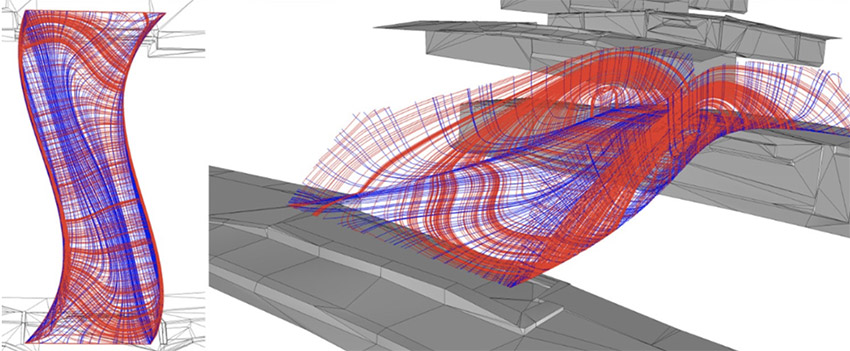
Image courtesy of MX3D
Figure 9. Images from structural analysis of MX3D's bridge.
Several studies have shown advantages for this building method in reducing emissions by reducing material needed – “progress toward achieving this, along with other ideas and findings related to this technology,” Gardner comments (Gardner, Kyvelou et al., Meng et al., Baqershahi et al.). In life-cycle assessments for other WAAM structural components, such as I-beams (Shah et al.), Gardner and colleagues have found that they outperform conventional hot-rolled beams of either carbon steel or stainless steel in emissions impact, provided the WAAM process results in mass reductions in the 50 percent range, a realistic saving with this technology. “Our machine uses a lot less energy than people typically think,” van der Velden notes; “robotic welding can be done with 4 or 5 kilowatts per hour or less,” and when renewable energy sources are used, the advantages accumulate. The collaborators on the Amsterdam bridge refrain from predicting how much of the future belongs to 3D-printed steel, and the question of whether it will remain a boutique technology or become a mainstream market mover is undecided. Yet the potential freedoms it offers architects are considerable, and the theoretical benefits for projects and for the planet certainly bear watching.
CONCLUSION
Criteria for selecting structural metals, Houska summarizes, include longevity, suitability for an application environment (e.g., stainless steel where corrosion resistance is a priority), energy absorption (with steel obviously preferred to aluminum if temperatures are high or blast impact is a risk), and now environmental resilience: once a value-added option, now a central driver of ideas. The sustainable-steel field is maturing, though the various parties involved in design, procurement, regulation, and construction decisions often operate from different information bases.
Pilarczyk reports that clients are often aware of LEED, the best-publicized among green standards in the U.S., but less informed about the specific goals the program sets for structural steel or any other element. “When we're talking to folks about sustainability in general, and we ask them, 'What are your sustainability goals for this project?', a lot of times what we get back is, 'Well, we're looking for LEED certification of some sort.' I think that's a definition that's ingrained... that's synonymous with sustainability. But really, we're talking more in depth about the embodied carbon of the steel and of the building itself, and not necessarily the LEED ratings.” More specific metrics for sustainably sourced materials logically lead to better-informed decisions. Pilarczyk describes before the Buy Clean Initiative, meeting designers and owners who had good intentions and would say “'We want to take the industry average and cut it in half,' and set those limits as the threshold for all the steel on their projects. And then we start to realize there's no steel that's made in the world that can meet these.”
Well-intentioned but haphazard alternatives to BAU are now giving way to clearer standards and, equally important, attention to suppliers' capability of meeting them. “The challenge that we're seeing now is, how do we actually have the procurement and supply chains in place to make sure that we're meeting the thresholds that are being set?” When one facility out of several has the lowest number on an Environmental Product Declaration (EPD), Pilarczyk says, “if everybody said that they wanted all their steel to come from that one facility, it just would totally disrupt the supply chain that's out there.” Locations of mills and logistical planning can span the gap between intentions and performance; “certain materials travel [or] are more regional than others. A beam mill like we have in Arkansas is completely capable of supplying steel across the country, just based on the rail systems, the rivers and barge systems, or just on the back of trucks.... It's when you start looking at materials coming from overseas and some of the disruptions that we saw in the last couple of years, with canals getting stopped up, changes on a project, or material that's incorrect, having to reship those from overseas can really cause major disruptions to the projects.” Fortunately for U.S. architects and steelmakers, and arguably for the planet, the facilities using the most progressive technologies are proliferating, and the operators of the others are presumably paying attention.
WORKS CITED
1American Institute of Steel Construction. Buy Clean Guidance for Structural Steel Products. Nov. 2, 2022. https://www.aisc.org/contentassets/937a380ddd404a2da0c48669d438bf3b/buy-clean-guidance-for-structural-steel-products.pdf.
2Architecture 2030. Why the Built Environment? https://www.architecture2030.org/why-the-built-environment.
3Baqershahi MH, Ayas C, Ghafoori E. Design optimisation for hybrid metal additive manufacturing for sustainable construction. Engineering Structures, February 2024. DOI: 10.1016/j.engstruct.2023.117355.
4Brady T, Eggert R. Ferrous scrap’s role in decarbonizing steel: assessing steel product lifespans. Steel Manufacturers Association, May 3, 2023. https://acrobat.adobe.com/link/track?uri=urn%3Aaaid%3Ascds%3AUS%3A7ebd5f57-ae76-3810-93aa-1b3b586345d2&viewer%21megaVerb=group-discover.
5Carbon Leadership Forum. The Carbon Challenge. March 31, 2020. https://carbonleadershipforum.org/the-carbon-challenge.
6Gardner L. Metal additive manufacturing in structural engineering – review, advances, opportunities and outlook. Structures 2023; 47: 2178-2193. https://doi.org/10.1016/j.istruc.2022.12.039.
7Gardner L, Kyvelou P, Herbert G, Buchanan C. Testing and initial verification of the world’s first metal 3D printed bridge. Journal of Constructional Steel Research 2020; 172, 106233. https://www.researchgate.net/profile/Leroy-Gardner-2/publication/342822366_Testing_and_initial_verification_of_the_world%27s_first_metal_3D_printed_bridge/links/5f0cc4f8299bf1074456ce40/Testing-and-initial-verification-of-the-worlds-first-metal-3D-printed-bridge.pdf.
8Giusti AC, Leggate J. US Steel, Nucor build major mills amid steelmakers' modernization. Engineering News-Record, Jan. 14, 2022. https://www.enr.com/articles/53439-us-steel-nucor-build-major-mills-amid-steelmakers-modernization.
9Global Steel Climate Council. The Steel Climate Standard: Framework for Steel Product Certification and Corporate Science-Based Emissions Targets. August 2023. https://globalsteelclimatecouncil.org/wp-content/uploads/2023/12/GSCC-Standard-August2023.pdf.
10Greenhouse Gas Protocol. Corporate Value Chain (Scope 3) Accounting and Reporting Standard: Supplement to the GHG Protocol Corporate Accounting and Reporting Standard. https://ghgprotocol.org/sites/default/files/standards/Corporate-Value-Chain-Accounting-Reporing-Standard_041613_2.pdf.
11Hasanbeigi A. Steel Climate Impact: An International Benchmarking of Energy and CO2 Intensities. Global Efficiency Intelligence, St. Petersburg, Fla., 2022. https://static1.squarespace.com/static/5877e86f9de4bb8bce72105c/t/624ebc5e1f5e2f3078c53a07/1649327229553/Steel+climate+impact-benchmarking+report+7April2022.pdf.
12Kyvelou P, Spinasa A, Gardner L. Testing and analysis of optimized wire arc additively manufactured steel trusses. Journal of Structural Engineering 2024: 150 (3). https://doi.org/10.1061/JSENDH.STENG-12832.
13Meng X, Weber B, Nitawaki M, Gardner L. Optimisation and testing of wire arc additively manufactured steel stub columns. Thin-Walled Structures 2023; 189: 110857. https://doi.org/10.1016/j.tws.2023.110857.
14Muslemani H, Liang X, Kaesehage K, et al. Opportunities and challenges for decarbonizing steel production by creating markets for ‘green steel’ products. Journal of Cleaner Production 2021; 315:128127. https://static1.squarespace.com/static/596a539de4fcb5edd0dad77f/t/60f97aa84d80571ef0fa72ce/1626962606599/Muslemani+et+al.+2021+JCP.pdf.
15Nippon Steel Corporation. Start of studies to shift from blast furnace steelmaking process to electric arc furnace steelmaking process. News release, May 10, 2023. https://www.nipponsteel.com/common/secure/en/news/20230510_400.pdf.
16Oldfield P. Post to Twitter (now X), July 18, 2021. https://twitter.com/SustainableTall/status/1416729492748345349.
17Reed S. How to clean up steel? Bacteria, hydrogen and a lot of cash. New York Times, March 17, 2021; updated May 14, 2021. https://www.nytimes.com/2021/03/17/business/steel-emissions-arcelor-mittal.html
18Shah IH, Hadjipantelis N, Walter L, et al. Environmental life cycle assessment of wire arc additively manufactured steel structural components. Journal of Cleaner Production 2023; 389: 136071. https://doi.org/10.1016/j.jclepro.2023.136071
19Shen X, Myllyvirta L. China’s steel sector invests USD 100 billion in coal-based steel plants, despite low profitability, overcapacity and carbon commitments. Centre for Research on Energy and Clean Air, Aug. 1, 2023. https://energyandcleanair.org/publication/chinas-steel-sector-invests-usd-100-bn-in-coal-based-steel-plants-despite-low-profitability-overcapacity-and-carbon-commitments/.
20State of California. Buy Clean California Act: Public Contract Code Sections 3500-3505. Passed Oct. 2017; effective Jan. 1, 2018. https://www.dgs.ca.gov/PD/Resources/Page-Content/Procurement-Division-Resources-List-Folder/Buy-Clean-California-Act.
21United States Code, 2014 Edition. Title 23 – Highways, Chapter 3 – General Provisions. Sec. 313 - Buy America. U.S. Government Publishing Office, www.gpo.gov. https://www.govinfo.gov/content/pkg/USCODE-2014-title23/html/USCODE-2014-title23-chap3-sec313.htm.
22United States, Executive Office of the President [Joseph Biden]. Executive Order No. 14057. Catalyzing clean energy industries and jobs through Federal sustainability. Federal Register Vol. 86, No. 236, December 8, 2021. https://www.govinfo.gov/content/pkg/FR-2021-12-13/pdf/2021-27114.pdf.
23U.S. Department of Energy. Industrial Decarbonization Roadmap. Publication DOE/EE-2635. Washington, DC: September 2022. https://www.energy.gov/sites/default/files/2022-09/Industrial%20Decarbonization%20Roadmap.pdf.
24U.S. Energy Information Administration. Manufacturing Energy Consumption Survey (MECS): 2018 MECS survey data. Feb. 23-Aug. 27, 2021. https://www.eia.gov/consumption/manufacturing/data/2018/. See Table 3.2: Energy Consumption as a Fuel by Manufacturing Industry and Region.
25U.S. Energy Information Administration. Natural gas explained: natural gas and the environment. Nov. 7, 2022. https://www.eia.gov/energyexplained/natural-gas/natural-gas-and-the-environment.php.
26U.S. Environmental Protection Agency. Reducing embodied carbon of construction materials through the Inflation Reduction Act. Sept. 28, 2023. https://www.epa.gov/greenerproducts/reducing-embodied-carbon-construction-materials-through-inflation-reduction-act.
27World Steel Association. Worldsteel announces the 2022 Steel Sustainability Champions. News release, April 12, 2022. https://worldsteel.org/media-centre/press-releases/2022/worldsteel-announces-the-2022-steel-sustainability-champions/.
28World Steel Association. Sustainability Indicators: Sustainability Performance of the Steel Industry 2004-2022. Brussels, 2023. https://worldsteel.org/wp-content/uploads/Sustainability-indicators-report-2023.pdf.
29Wynne Z, Buchanan C, Kyvelou P, et al. Dynamic testing and analysis of the world's first metal 3D printed bridge. Case Studies in Construction Materials 2022; vol. 17: e01541. https://doi.org/10.1016/j.cscm.2022.e01541 (https://www.sciencedirect.com/science/article/pii/S2214509522006738).
30Zhang M, Chow E. China plans to increase iron ore output, boost use of steel scrap. Reuters, Feb. 7, 2022, https://www.reuters.com/article/idUSL1N2UI0FL/.
Bill Millard is a New York-based journalist who has contributed to Architectural Record, The Architect’s Newspaper, Oculus, Architect, Metals in Construction, OMA’s Content, and other publications.









